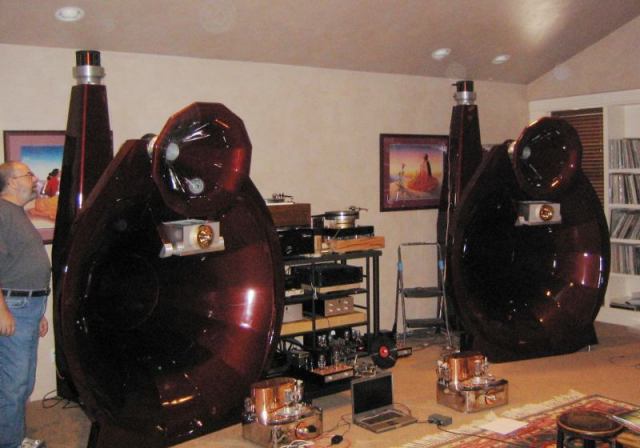|
It looks like the Cogent boys came up with a new design. It is good that they are keep looking, even thogh they unfortunately are restricted with their desire to stretch the use of their drivers over too wide bandwidth….
The new Cogent setup look like a large sloppy genitalia, witch is not necessary a bad thing. Still, when I see those horns I would like to crawl inside, to lie down and to purr…

The Cogent went for a larger opening at their upper bass horn – that is very-very good. Their older upper bass hors sounded like sewer pipe (despite all reports for different Morons ™ that you might heard), primary due to the pressure from their midbass was choked at the small mouth. This new upperbass or perhaps midbass horn is WAY more interesting solution.
But here is where we hit the fundamental limitation of any 2-3 ways installation that has “no-cheating” midbass horn – there is no way to organize other channels in nearfiled. Let see how the Cogent boys were forced to screw up own installation because of it.
The MF channel looks like 150-200Hz horn. That would make the MF crossover point around 350Hz. The horn sits 7 feet tall and angled down. The horn angling is very bad thing. I also not a big fan of conical horns. It looks like Bill Woods from:
http://www.acoustichorn.com/
have sold to the Cogent boys the “BS literature” about the imaginary advantages of the conical horns. I do not buy into it, particularly for HF. So, we have the two way Cogent setup, ala Klangfilm-type of setups with MF driver shooting from the roof. Then Cogent boys added a tweeter - a long needed action.
Cogent vent for German Acapella’s ionized gas tweeter. There was in past many attempts to make the ion tweeters to work (DuKane, Electro-Voice, Fane etc) and nowadays Acapella makes them. The subject of the ion tweeters itself might a separate subject. I have problems with it when I hear it, although it should be theoretical the best solution for a tweeter. The most important is the incorporation of the plasma tweeter into the rest of acoustic system as plasma tweeter always sounds different then the rest of the channels. Even the Acapella’s own speakers do have this behavior…. However, I think Cogent might have a good shot with plasma tweeter as some idiosyncrasies that I recognize (and do not like) in ionized tweeters are presented in the sound of the Cogent’s drivers as well. I am talking about that “slippery sound” when sonic granularity goes all that way down (positive thing) but along with loosing granularity the transport for the ‘events delivering” is also diminishes (negative thing). So, perhaps the Cogent-Acapella integration might work out in their own right, though I would personally would like to see more sensitively in Cogent’s tweeter 10dB more then Acapella can handle.
Then we heat the painful part – the location of the Cogent’s tweeter – there is no right for it. The Cogent placed it at the only reasonable spot, - severely fucking up time alignment in their system – how people can listen the time-misaligned horns – do they have any idea or understating what they listen? The Cogent, however, took it further into absurdity – they aligned the tweeter’s axis with midbass horn but not with the MF horn. This setting will have the ONLY ONE proper distance where MF and HF channel will sound aligned; any other locations, even one away will reply with tweeter time offset.
What I think the Cogent boys should do (besides going for another channel) is to find the way to lover the MF channel down. Then I would like them to work with Acapella (if they like the driver) to make for them a tweeter with much smaller facade footprint, taking all Acapella’s guts, alosn with converter, off the tweeter’s board. That would allow Cogent to bring the tweeter all the way deeper and time-aligned it with the MF driver…
Until then the Cogent boys should keep experimenting. The given installation dos not look as a prototype of experiment installation but it is rather looks like completed product. I am not impressed.
The good sign that the Cogent went for better electronics. I heard some horrible stories how the Cogent systems were driven… I do not know how interning the Electronluv and what they know about sound but I think it should be more interesting then the typically-suffocating 300B when I was listening Cogent what I listening them a couple years ago at CES Rgs, Romy the Cat
|